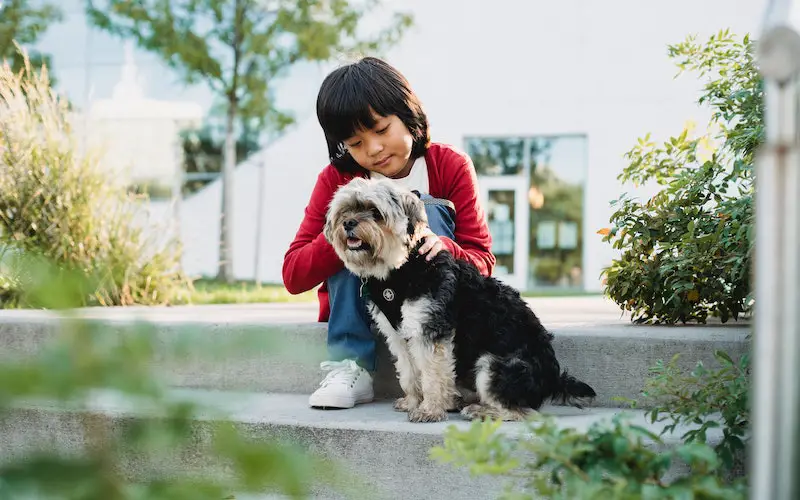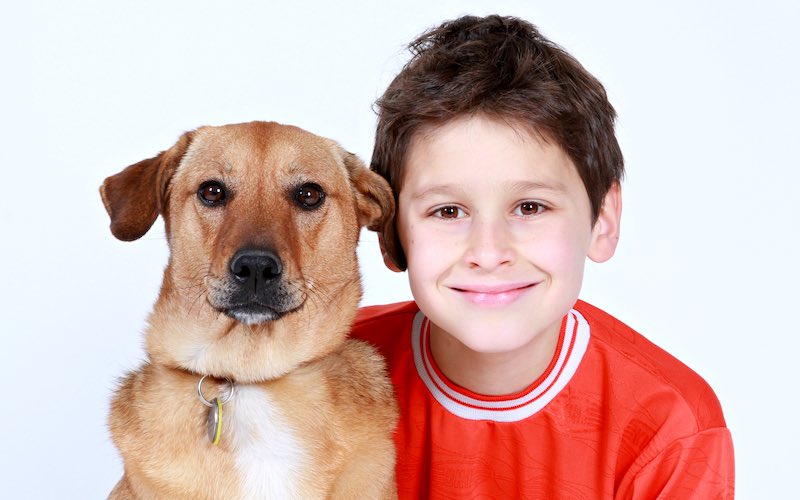You may be a dog owner considering becoming a foster parent. or possibly you may already be a foster carer who is considering a dog. Whatever your position, it is totally possible to do both. In this blog I will explore the pros and cons of owning a dog as a foster carer and also explore the ways that you go about it. So, can you foster a child if you have a dog?
Can you foster a child if you have a dog? Yes you can!
As well as being a dog owner, I am also a foster carer and love parenting both dogs and children! And so the answer to ‘can you foster a child if you have a dog?’ is clearly yes! Many foster family have dogs. In fact, a dog can be a good stabilising and reassuring animal to have around the house for children who have been through trauma, as long as the dog is well behaved and they form a good positive bond. First of all, let’s look at the pros and cons of fostering a child if you have a dog.
*No real names of any foster children in care have been used in this blog to protect their identity and respect confidentiality. The photographs used are stock images/Creative Commons and are not children in foster care.
Further resources on fostering: Olive Branch Fostering
The Pros of Owning a Dog as Foster Carers
There are many advantages of owning a dog as a foster family. Here are some of our highlights:
- A dog offers a good focus for family walks together which gets you exercising and talking.
- Exciting outings that you might not go on otherwise – we love going to Delamere Forest and Crosby beach with our dog and foster kids.
- Dogs can be very therapeutic for children who have been through trauma – stroking dogs is very relaxing.
- Often your foster child will develop a bond with your dog.
- Taking some responsibilities such as giving the dog treats, feeding the dog and letting the dog out the back to the loo are good ways for older children to understand and take responsibility.
- Dogs do funny tuff like chasing their tails and doing tricks – this can make kids laugh and be a great ice breaker when they first arrive in your home.
- Dogs offer a good talking point – ‘How do you think that Rex would feel if X happened?’ and this can offer an opportunity for open conversations about feelings.

The Cons of Owning a Dog as Foster Carers
Although we find owning a dog to be a plus in our household and we love to see our foster kids bond with him, it’s certainly not without its challenges. Here are a few negatives or challenges that you should consider:
- Some dogs may become aggressive or snappy around children that they are not used to and so expect to have a ‘dog assessment’ to determine that your dog will be safe with children.
- You will not be able to leave your foster kids and dog alone in the same room together (but never leave any child unattended with a dog for that matter, regardless of how much you trust them).
- You will need to teach your foster child(ren) how to behave around the dog if they have never experienced living with one before.
- House training – your dog will have to be house trainedf your dog poops either inside or outside it will need to be immediately cleaned up and children kept away as dog poop is unhygienic and can carry diseases.
- At certain times of year such as bonfire night you will need to be particularly alert. Your dog may be too scared to be left alone which could mean skipping the firework displays This is easier when there are two of you as carers – one can take the kid and one can look after the dog!
- Your dog will probably need a baby gate to stop him running up the stairs where he may trip you up – this can be especially dangerous if you are carrying a toddler downstairs and trip and fall.
- Your dog will probably need to sleep downstairs, particularly if you have a small child who you may need to wake up to in the night if they are sick or cannot sleep due to nightmares.
- If your dog sheds a lot of fur you will need to hoover and clean frequently as fostering children requires a high standard of cleanliness and safety in your house.
- Remember that if your dog is on any form of medication this will need to be locked away so that children cannot access it.
So becoming a foster carer as a dog owner – how do you do it?
Woah, that was a longer list of pros and cons than I expected! let’s now take a look at the process of becoming a foster caring when you have a dog.
First of all, you will need to decide what kind of foster carer you want to become – long term, respite or foster to adopt. Remember that some agencies don’t do foster to adopt so be sure to choose an agency that fits in with your longer term goals. You will also need to decide whether you go through the local authority route or private fostering agency route.
When you apply to become a foster carer you will then go through extensive reference checks and medicals. You proceed to a lengthy report by a social worker called a ‘Form F’. This process can take 3-6 months and be prepared to answer quite personal questions about your past and your relationship.
Foster Carer Dog Assessment
Once you are approved as a foster carer – well done! This is a lengthy process and a big achievement. Next is the pet assessment – it is usual for any family who have pets to go through an assessment to determine their suitability to have children in the home. This is important for health and safety – you cannot have an unruly or aggressive dog if you are fostering. Provided your dog is friendly and nice natured you should have no problem at all with passing the pet assessment.
Our experience of the dog assessment was that the appointment was made and an experienced dog assessor came to the house – this is a person with a specialism in dog behaviour rather than coming from a social work perspective (the social workers opinion has already been done on the Form F).
The assessor fussed our dog at the door and it was a positive that he was a ‘dog person’ because Blake could smell other dogs on him which got his tail wagging and a positive welcome.

The dog assessor had a look around our house at where he eats, sleeps and observed his behaviour. This involved him giving the dog a fuss and a treat, observing him doing basic obedience and also watching Blake follow the ‘in your bed’ command when he got a bit too excited! We were asked about his behaviour on walks and with new people. Blake is quite a ‘high energy’ dog and so the dog assessor gave advice on getting the baby gate and keeping him in the kitchen when new people first arrive, then greeting when everyone is more settled down (rather than greeting at the door).
We discussed safety issues such as not letting the dog get close to children’s faces and never leaving them alone unattended (which we already understood). We also discussed health for the dog including how often we poop scoop the yard (daily!) and the fact that his worming and de-flea treatment was up to date (which it was). We also showed evidence of our pet insurance.
At the end of the assessment the dog gets graded as Low Risk, Medium Risk or High Risk. Our dog was low risk which was fantastic and means children are allowed. A medium risk dog may need further training and rehabilitation which extra rules in place. A high risk dog (a dog that bites or attacks) may not be suitable to be in a home with foster children.
Starting to Foster with our Dog at Home
Blake was initially quite ‘Barky’ when we first introduced children into our home, but he quickly bonded with our first foster child and they enjoy keeping each other company. Our dog gets freaked out by fast movements or people raising their arms (due to his history of abuse) and so we have had to teach and remind children in our care to move slowly and gently around the dog. They enjoy giving him treats and making him do tricks like stand, spin and paw.
We have found that sometimes it can be a handful when the dog needs a walk and the child doesn’t want to – thankfully there are two of us and so one can go walking with the dog while the other stays at home with the foster child. This means that we can give our foster children choices which they appreciate. I think that aspect would be harder if I was a single foster carer.
Overall we have really enjoyed sharing our home (and dog!) with foster kids. One of them even said ‘without Blake your life wouldn’t be so happy, would it?!’ What a compliment to our lovely little dog!
Further Reading
You might also find the following articles interesting:

